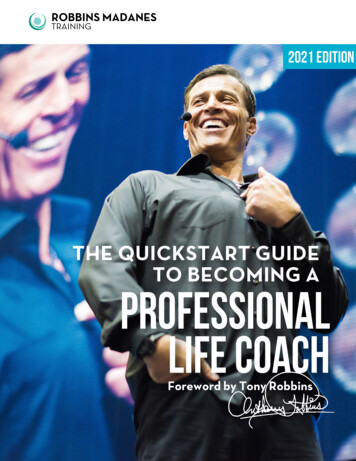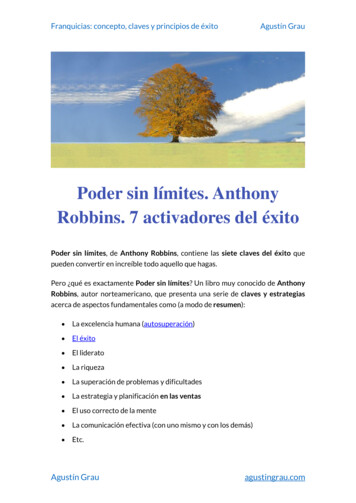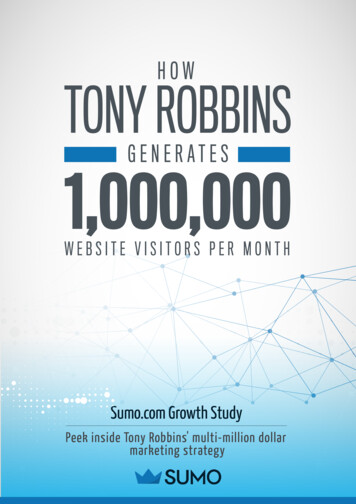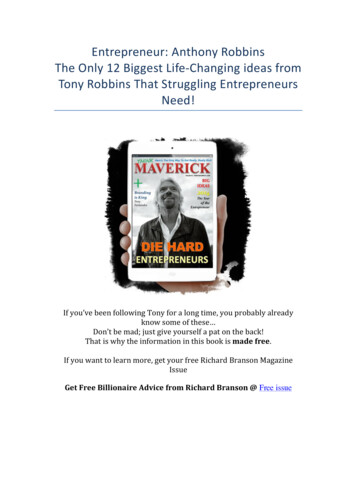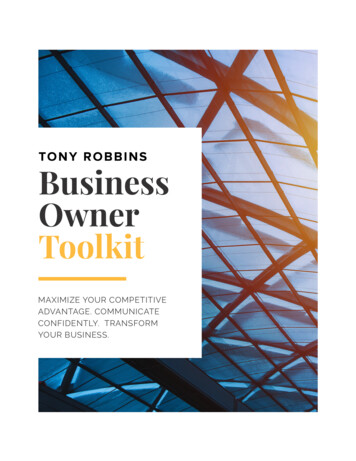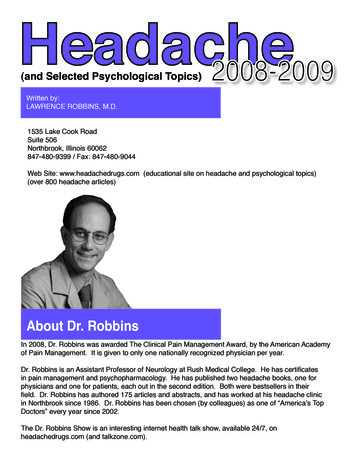
Transcription
(and Selected Psychological Topics)Written by:LAWRENCE ROBBINS, M.D.1535 Lake Cook RoadSuite 506Northbrook, Illinois 60062847-480-9399 / Fax: 847-480-9044Web Site: www.headachedrugs.com (educational site on headache and psychological topics)(over 800 headache articles)About Dr. RobbinsIn 2008, Dr. Robbins was awarded The Clinical Pain Management Award, by the American Academyof Pain Management. It is given to only one nationally recognized physician per year.Dr. Robbins is an Assistant Professor of Neurology at Rush Medical College. He has certificatesin pain management and psychopharmacology. He has published two headache books, one forphysicians and one for patients, each out in the second edition. Both were bestsellers in theirfield. Dr. Robbins has authored 175 articles and abstracts, and has worked at his headache clinicin Northbrook since 1986. Dr. Robbins has been chosen (by colleagues) as one of “America’s TopDoctors” every year since 2002.The Dr. Robbins Show is an interesting internet health talk show, available 24/7, onheadachedrugs.com (and talkzone.com).
TABLE OF CONTENTSGENERAL INFORMATIONPageInformation for Headache PatientsNon-Medication Strategies for Headache PatientsFoods to AvoidSources of CaffeineCharacteristics of Migraine, Chronic Daily, and Cluster HeadacheKeys to Headache ManagementExercise, Weight Loss, and Supplements for General HealthBiofeedbackClinical Pearls for Treating Headache PatientsRebound (Withdrawal) Headache4456788101216MIGRAINEFirst Line Migraine Abortive MedicationsSecond Line Abortive Migraine MedicationsAntiemetic MedicationInformation that Patients Need to Know Prior toStarting Prevention MedicationFirst Line Preventative Medications for MigraineSecond Line Migraine Preventative TherapyPreventative Medication: When to Proceed Quickly withTwo Preventives at One TimeThird Line Migraine Prevention“Natural” Headache Herbs/SupplementsTreatment of Menstrual Migraine17182021222325252728TENSION AND CHRONIC DAILY HEADACHEFirst Line Tension Headache Abortive MedicationsSecond Line Tension Headache Abortive MedicationsButalbital (Fiorinal) CompoundsFirst Line Chronic Daily Headache (CDH) Prevention MedicationSecond Line CDH Preventative MedicationThird Line CDH Preventative Therapy283031313233CLUSTERIntroduction to Cluster HeadacheFirst Line Abortive Medications for Cluster HeadacheQuick Reference Guide: First Line Cluster Preventive Medication2333536
HEADACHE IN CHILDREN AND ADOLESCENTSIntroduction: Headache in Children and AdolescentsAbortive Tension Headache Medications in Children(Less than 11 years old)Abortive Migraine Medications in Children(Less than 11 years old)Preventative Headache Medications in Children(Less than 11 years old)Abortive Headache Medications in Adolescents(11 years and older)Headache Preventative Medications in Adolescents373838394040DEPRESSION AND ANXIETYDepressionAnxietySSRI’s (Selective Serotonin Reuptake Inhibitors):Prozac, Zoloft, Paxil, Celexa, LexaproWellbutrin, Remeron, Effexor, and Cymbalta41424346BIPOLAR, ADD, PERSONALITY DISORDERS, INSOMNIA, and FATIGUEBipolar: Description and MedicationAttention Deficit DisorderPersonality DisordersInsomniaFatigue4850535557THE CYP 450 ENZYME SYSTEMCYP ENZYMES:Substrates, Inhibitors, and Inducers58INSTRUCTIONS FOR rforforforforPatients: MaxaltPatients: RelpaxPatients: ZomigPatients: AxertPatients: FrovaPatients: AmergePatients: Imitrex63646566676970This guide is the author’s opinion; medications must be individualized and used only inconjunction with your physician. Side effects, as listed in the PDR, must be acceptedand understood. Many of the medications listed do not have an official FDA indicationfor the condition discussed. This guide is not a prescription, and does not represent“standard consensus” treatment. It may not be copied; copyright pending.3
INFORMATION FOR HEADACHE PATIENTSNon-Medication Strategies for Headache PatientsWith migraine and chronic daily headache sufferers, we like to emphasizeavoidance of triggers. The most common triggers are, in descending order:stress, weather changes, perimenstrually, missing meals, bright lights or sunlight,undersleeping, foods, perfume, cigarette smoke, after stress is over, oversleeping, exercise, and sexual activity.Headache patients, in general, do better with regular schedules, eating three ormore meals per day and going to bed and awakening at the same time every day.Managing stress with psychotherapy, exercise, yoga, etc., often will reduce theheadaches. The “headache foods” tend to be overemphasized as a headachetrigger.Sleeping is crucial; sleeping on a regular schedule, and enough, usually helps.Exercise for 15 to 20 minutes per day (or more) is often helpful for headachepatients; if patients will do the treadmill, bike, or walk on average 15 minutes perday, they will achieve 80% of the goals of exercise. Relaxation techniques suchas biofeedback, deep breathing, and imaging can be helpful for daily headachepatients, particularly where stress is a factor. Regarding stress, it is not so much“bad stress”, but “daily hassles” that increase headaches. When patients arefaced with overwhelming daily hassles, particularly when they cannot sleep wellthat night, headaches can be worse the next day.Psychotherapy is extremely useful for many headache patients with regard tostress management, coping, life issues, family of origin issues, etc. Patients canoften learn relaxation techniques from books or tapes that are readily available inbookstores, so that learning relaxation techniques often does not require extendedvisits to a therapist. If patients are willing and able to see a therapist, working witha therapist who teaches biofeedback can be very useful. However, even thoughwe may recommend psychotherapy, it is crucial to legitimize the headaches as aphysical condition; they are not a “psychological” problem, but rather a physicalone that stress may exacerbate.Yoga may be helpful for some headache patients. The idea is to take a class onceweekly, and then do the yoga stretches and breathing for 5-10 minutes per day.This may help associated neck or back pain. Physical therapy may also be helpful.Massage may be useful, particularly for the neck pain.4
The following are the general food lists including the sources of caffeine thatwe have found useful in migraine patients:Foods to Avoid, and Sources of Caffeine:(Foods are often overemphasized as triggers)You may or may not be sensitive to any of the following foods. If a particular foodis going to cause a headache, the headache will usually occur within three hoursof eating. Also, the response to the foods may not be consistent. On oneoccasion, you may have a headache caused by a particular food; however, thenext time you eat that same food, it is possible that a headache may not occur.While foods are not as common a headache trigger as stress, weather, hormones,missing meals, bright lights, and undersleeping, some patients are sensitive to thefollowing: Monosodium Glutamate (MSG) – also labeled Autolyzed Yeast Extract, Hydrolyzed Vegetable Protein, or Natural Flavoring. Possible sources of MSG include broths or stocks, seasonings, wheyprotein, soy extract, malt extract, caseinate, barley extract, textured soyprotein, chicken or port or beef flavoring, smoke flavor, spices,carrageenan, meat tenderizer, seasoned salt, TV dinners, instant gravies,and some potato chips and dry-roasted nuts.Red Wine (White wine is not as likely to trigger a headache)BeerAll alcohol can trigger a headache; beer and wine are the worst offendersChocolateCitrus Fruits, ripe bananas.Ripened, aged cheeses (Colby, Roquefort, Brie, Gruyere, cheddar, blue, brick,mozzarella, Parmesan, boursalt, Romano) and processed cheese. Not likely to trigger headache: cottage cheese, cream cheese, andAmerican cheese.Hot dogs, pepperoni, bologna, salami, sausage, canned or cured meats(bacon, ham), aged meats, or marinated meats.Nuts, peanut butter, large amounts of Nutrasweet.Yogurt, sour cream.CaffeineWhile caffeine can help headaches, the overuse of caffeine may increase viarebound mechanisms. Some patients do not suffer rebound headaches from theingestion of 500 mg. of caffeine per day, while others develop rebound headacheswith as little as 30 mg. In general, I like to limit caffeine to 150 mg., or at most,200 mg. per day.The average 8 ounce cup of coffee has 75 to 125 mg. caffeine. Drip coffee isstronger than percolated, and instant is the weakest form. Depending on the sizeof the cup and its strength, instant coffee may contain from 40 to 150 mg., but isusually closer to 40 mg. Decaffeinated coffee contains from 2 to 5 mg. per cup.However, the caffeine levels may be much higher at restaurants and coffeehouses. These calculations all depend upon the strength of the product and thebrew. Specialty coffeehouses (Starbucks, Caribou, etc.) often contain twice theusual amount of caffeine per cup.5
Tea usually contains 30 to 50 mg. of caffeine per cup, and soft drinks averageapproximately 40 mg.Chocolate contains 1 to 15 mg. of caffeine per ounce; however, cocoa hasconsiderably more caffeine, up to 50 mg. for an 8 ounce serving.Caffeine is available in both food products and as tablets or capsules. Caffeinetablets such as NoDoz, Tirend, and Vivarin are available, but I do not use thehigher strength products. Beware of “energy drinks.”When patients find that caffeine significantly decreases their headaches, I willoccasionally utilize the pure caffeine tablets, with a dose of 1/2 of a 100 mg. pill(50 mg. total) every 3 to 4 hours as needed. At times, it is helpful to combine thecaffeine with medications that do not contain caffeine.In whatever form that patients receive caffeine, whether in coffee, caffeine pills, orcombination analgesics, it is necessary to limit the total amount of caffeine. Themaximum amount of caffeine to take each day varies from person to person,depending upon their sleeping patterns, the presence of anxiety, and theirsensitivity to possible rebound headaches.Caffeine SourcesLimit caffeine to 150 mg. per day, or, at most, 200 mg. per dayCoffee: 8 ounces: average cup: 75-125 mg.drip is stronger than percolated, which is stronger than instantinstant 40-150 mg. per cup, usually closer to 40 mg.decaf 4 mg. per cup (but may be much more)latte 90 mgTea: 8 ounces: average cup: 30-50 mg.Soft drinks: approximately 40 mg. per cupChocolate: 1-15 mg. per ounceCocoa - 50 mg. per 8 ouncesCaffeine tablets: (NoDoz, Vivarin, Tirend) 100 mg. of caffeineCaffeine is present in many analgesic medications, such as Excedrin Migraine (65mg.), Anacin (32 mg.) and Vanquish (33 mg.) MigraTen has 100mg. of caffeine.6
Characteristics of Migraine, Chronic Daily, and Cluster HeadacheCharacteristics of Migraine:Attacks are 4 to 72 hoursModerate or moderate-to-severe painHistory by the patient gives the diagnosis, not lab testsOften early morning, but may be anytimeUnilateral in one half of patientsOne to five migraines per month is typical\Gradual onset of pain, a peak for hours,slow declinePain is throbbing, pounding, pulsatile, or deep achingSharp “ice-pick” jabs are commonPeak ages are between 20 and 35 years18% of women, 7% of men experience migraine in their lifetime; female/male ratiois 3:1Family history is often positive for migraineAssociated nausea, photophobia, blurred vision, phonophobia, dizziness iscommon; however, these may be absentIn women, there is often a positive relationship with mensesCold hands and feet, or motion sickness is common in migraine patients.Criteria for Chronic Daily Headache (CDH):1. Chronic tension headache; more than 4 hours per day, and 15 or more daysper month. The chronic daily headaches usually evolve over a period ofmonths or years.2. Transformed migraine: more than 4 hours per day, and 15 days per month.Previous history of migraine. There is usually a slow increase in tension typeheadache, with a concomitant decrease in migraine features. No organiccauses. Eighty percent of transformed migraine patients have been reported tooveruse analgesics. The analgesic abuse may create the daily headaches insome of these patients. Most common reason for daily headache. “ChronicMigraine” is a term for frequent/daily headaches with migraine features.3. New daily persistent headache: sudden (over 1 to 3 days) onset of chronicdaily headache. No significant previous migraine history, but patients mayhave had episodic tension headaches in the past.4. Posttraumatic chronic daily headache: often present with migrainous features.Very difficult to effectively treat. Does not seem to be responsive to the usualmedications.5. Headache associated with cervical spine problems, particularly arthritis: usuallyposterior occipital. Can be exceedingly difficult to effectively treat.6. Chronic migraine: CDH that has migraine features (throbbing pain, one-sided,with nausea, sensitivity to light or sound, dizziness).This guide is the author’s opinion; medications must be individualized and used only inconjunction with your physician. Side effects, as listed in the PDR, must be acceptedand understood. Many of the medications listed do not have an official FDA indicationfor the condition discussed. This guide is not a prescription, and does not represent“standard consensus” treatment. It may not be copied; copyright pending.7
Links Connecting Tension and Migraine Headache:Both respond to similar medications: antidepressants and Triptans.Similar serotonergic changes are found in tension and migraine headache patients.Neck pain and muscle spasm are common to both tension and migraine.Family history of headache is present in both migraine and tension headachepatients.Cranial muscle tenderness and cerebral blood flow changes are common toboth conditions.Mild migraine is very difficult to clinically distinguish from a severe tensionheadache.The vast majority of patients with CDH also experience migraine.Typical Characteristics of Patients with Cluster Headache:Begin between ages 20 and 45, approximately 1 out of 250 menMale predominance (3:1)Same time of year, with no headache in between the cluster cyclesPrimarily nocturnal attacksDuring cluster cycle, alcohol triggers the headachesSevere, excruciating, unilateral pain, usually periorbital, 45 minutes on averageIpsilateral rhinorrhea, lacrimation, conjunctival hyperemia, sweating of theforehead, Horner’s syndrome90% of patients have episodic cluster, with breaks between cycles of months.10% suffer from chronic cluster, with no significant breaks.Keys to Headache Management1.2.3.4.5.Watch headache triggers (sleep on a regular schedule and get enough sleep)Treat a migraine early in the headacheDo not overuse pain meds/abortives; try and limit to 3 days a weekIf appropriate, treat with preventative meds (Botox is a preventive)Watch sleep and eating, exercise, do yoga or other relaxation techniques.Exercise, Weight Loss and Supplements for General HealthExerciseExercise will sometimes help headaches. It certainly is crucial for weight loss.To get 80% of the benefits of exercise, you only need to think of exercising in littlechunks of time - 10 to 20 minutes. Most people are able to fit it more easily intotheir life when thinking this way. First thing in the morning, getting up and walkingor using the treadmill or riding the bike for 10 or 15 minutes provides you with atleast the minimum daily exercise. We are looking for 20 to 30 minutes onaverage, but 10 or 15 minutes will do. For weight loss, we need to increase it to40 to 60 minutes daily. Having a treadmill or a bicycle at home, a headset forwalking, or belonging to a health club can help.8
Weight Loss (visit www.sparkpeople.com good free site)Permanent weight loss is difficult. It takes a huge effort, and a change in life style andbehavior. It never comes about by saying “I need to watch my weight, lose a fewpounds and exercise”. It only really comes about via a concerted effort where exerciseand weight control are a main project in your life. You need to get up that morningthinking about it and thinking how am I going to get my exercise and what am I going toeat today. Recently, a university studied over 5000 people who kept weight off longterm. Some of the keys to long-term weight loss, which all of these people seemed tofind on their own, included the following:7 Keys to Long-Term Weight Loss1.2.3.4.5.6.7.Exercise 40-60 minutes daily (walking, biking, treadmill)Graze (small meals throughout the day)Portion controlCount calories (or points; Weight Watchers is a good programWeigh yourself oftenEat low-fat foodsDo NOT dietSupplements for General HealthMost herbs/vitamins have not held up to scrutiny; many have turned out to be harmful.Even multivitamins are questionable, particularly in men (a recent study indicated thatmen who have prostate cancer may have a more severe form of the cancer if they weretaking multivitamins). The following have held up to scrutiny.CalciumAs we age, our absorption of calcium goes down. After age 45, most people,particularly post-menopausal women, should probably take calcium supplements.Calcium is found in milk, yogurt, cheeses, broccoli, tofu, some fruit juices or fortifiedcereals, and some other foods.Calcium citrate has advantages over calcium carbonate. Citrocal Caplets plus D are agood form of calcium and D; they have 315 mg. of calcium plus 200 IU of D; the usualdose is one or 2 twice a day. Our system cannot absorb more than 500 mg. of calciumat one time. Consult your physician. To learn about calcium, www.nih.gov (and thensearch calcium) is a good site.9
Vitamin DVitamin D is important for skin and bones, and it helps to prevent a number ofcancers (and probably Multiple Sclerosis). Most people in colder climates are lowin Vitamin D, as we are not in the sun enough. 1200 units per day should betaken, at least, of Vitamin D3, not D2. Almost all Vitamin D supplements (but notthe D in multivitamins) are D3, which is the kind that we want. Most people needto take a Vitamin D supplement. Do not take more than 2,000units of D withoutconsulting your physician. If you take calcium with D, you probably still need totake an extra D supplement.Omega-3's (Fish/Fish oil/Flaxseed)These have held up as beneficial for the heart, moods, and possibly headaches.Eating fish is good, particularly fatty fishes (tuna/salmon/trout/mackerel), and fishoil supplements are also beneficial. On the back of the fish oil bottle, choose thebrand with the most EPA and DHA. Taking 1 or 2 per day is recommended. Instudies, much higher doses have been utilized. Flaxseed capsules, or flaxseeditself, is also helpful. There are other sources of Omega-3's, such as tofu (andsoybeans), walnuts, and canola oil.AspirinIf you are at risk for heart disease, your doctor may recommend daily aspirin.Aspirin may help prevent heart attacks, strokes, and certain cancers. The dose isusually one (325 mg.) aspirin (Bayer or generic) a day. Baby aspirin (81mg) oraspirin (162 mg.) may be sufficient. The dose varies from person to person.Eventually we will test people's blood to determine the correct dose. In general, Irecommend one (325mg) aspirin per day. Aspirin can cause stomach ulcers; if ithurts your stomach or causes heartburn, stop it. Consult your physician.Biofeedback Training for Headache and AnxietyBiofeedback is a technique for developing greater awareness of and voluntary controlover physiological processes (like muscle tension) that are often beyond our awarenessand control. Sensitive recording instruments are used to measure and "feedback"physiological information back to the client about processes like muscle tension and skintemperature in order to develop control over them.In recent years, biofeedback techniques for treating headaches has improvedsignificantly. In the past, the focus was often on reducing
Third Line CDH Preventative Therapy 33 CLUSTER Introduction to Cluster Headache 33 . but rather a physical one that stress may exacerbate. Yoga may be helpful for some headache patients. The idea is to take a class once weekly, and then do t
